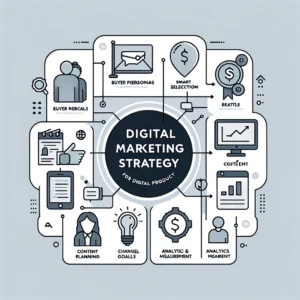In the complex world of business, Market Research and Analysis emerges as a beacon, guiding companies through murky market waters. This vital process not only unravels the intricacies of market dynamics but also shines a light on consumer behavior and competitive strategies, empowering businesses to carve their niche successfully.

Detailed Market Analysis Techniques: A Deep Dive
Unraveling the Complex Web of Market Analysis
Market analysis is not just a tool; it’s a multifaceted process that forms the backbone of strategic decision-making in business. At its core, market analysis seeks to demystify the intricate dynamics of the market – who the customers are, what they need, how they behave, and who else is vying for their attention. To achieve this, a blend of various methodologies is employed, each offering unique insights and contributing to a holistic market understanding.
Surveys and Interviews: The Pulse of the Market
- Surveys: A powerful tool, surveys can range from short online questionnaires to extensive paper-based ones. They are designed to gauge customer satisfaction, understand buying habits, and gather feedback on products or services. Crafting surveys that are both engaging and insightful is an art. They can be tailored for different segments, such as B2B or B2C, each requiring a unique approach in question design and delivery.
- Interviews: Offering a more personal touch, interviews allow for a deeper dive into consumer perceptions and opinions. There are several types:
- Personal Interviews: These involve direct, face-to-face interaction, providing an opportunity for detailed discussions and follow-up questions.
- Telephonic Interviews: Efficient for reaching a wider audience quickly, these are particularly useful for gathering immediate reactions or conducting brief surveys.
- Focus Groups: Bringing together a diverse group of people to discuss specific topics can unveil multifaceted views and generate rich qualitative data.
Advanced Analytical Techniques: Beyond Basic Insights
- Factor and Cluster Analysis: These statistical techniques delve into the underlying structure of market data. Factor analysis helps in identifying latent variables that influence consumer behavior, while cluster analysis groups consumers with similar characteristics, aiding in effective market segmentation.
- PEST Analysis: A strategic tool, PEST analysis examines the external macro-environment in which a business operates. It covers Political, Economic, Social, and Technological factors, providing a broader view of the market landscape that can impact strategic planning and risk management.
The Role of Digital Tools in Market Analysis
In today’s digital age, market analysis techniques have evolved to incorporate sophisticated digital tools. Data analytics software, social media listening tools, and online survey platforms have revolutionized how market data is collected and analyzed. These tools offer real-time insights and a vast amount of data, enabling businesses to quickly adapt to market changes and consumer trends.
In-Depth Consumer Behavior Insights: Understanding the Market’s Heartbeat

Consumer behavior is a complex tapestry woven from various threads of psychological, social, and economic patterns. Understanding this behavior is crucial for businesses aiming to resonate with their audience.
- Psychological Insights: Delve into the psychological underpinnings of consumer decisions. Factors like motivation, perception, learning, and beliefs significantly influence buying behavior. Employing psychological theories and models helps businesses predict how consumers are likely to respond to marketing strategies and product offerings.
- Social and Cultural Influences: Consumer behavior is not developed in isolation. Social factors such as family, reference groups, and culture play a pivotal role in shaping buying habits. Understanding these influences allows businesses to tailor their approaches to resonate with specific demographic segments.
- Economic Factors: Economic conditions and personal financial situations are key determinants of consumer behavior. In times of economic fluctuation, understanding how consumers adjust their spending habits can guide businesses in pricing strategies and product offerings.
- Adapting to Changing Trends: Keeping pace with the ever-evolving consumer trends is vital. The rise of digital technology and e-commerce has transformed how consumers interact with brands and make purchase decisions. Analyzing online behavior, social media engagement, and e-commerce trends offers insights into the modern consumer’s psyche.
Comprehensive Competitive Landscape Analysis: The Art of Business Warfare
More about go to market strategy
Competitive analysis is akin to a strategic game of chess. Understanding your competitors’ moves – their strengths, weaknesses, and strategies – can provide you with a significant advantage.
- Identifying Competitors: Start by identifying both direct and indirect competitors. This includes not just the current players but also potential entrants that could disrupt the market dynamics.
- Analyzing Competitors’ Strategies: Examine their marketing strategies, sales processes, customer service approaches, and product innovations. Understanding their tactics can reveal market gaps and opportunities for differentiation.
- Digital Presence and Engagement: In today’s digital world, analyzing competitors’ online presence is critical. This includes website traffic analysis, social media engagement, content strategy, and online customer reviews.
- SWOT Analysis: Conducting a SWOT analysis (Strengths, Weaknesses, Opportunities, Threats) for each major competitor can provide a structured way to evaluate their market position and anticipate their next moves.
Advanced Market Segmentation Strategies: Crafting a Targeted Approach
Market segmentation is not just about dividing a market; it’s about carving out niches and understanding the unique needs of each segment.
- Demographic Segmentation: This involves dividing the market based on variables like age, gender, income, occupation, and education. It’s a fundamental approach that helps tailor marketing messages to specific demographic groups.
- Psychographic Segmentation: Delving deeper, psychographic segmentation considers lifestyle, interests, values, and attitudes. This approach helps in aligning products with the intrinsic motivations and values of different consumer segments.
- Behavioral Segmentation: Analyzing consumer behavior based on usage rates, benefits sought, brand loyalty, and readiness to purchase can lead to highly effective targeting strategies.
- Geographic Segmentation: Tailoring offerings based on geographic variables such as regions, cities, or neighborhoods can significantly increase market relevance and customer engagement.
Innovative Data Collection Methods in Market Research: The Backbone of Market Insight
Data collection in market research is the foundation upon which market insights are built. It’s a multifaceted process that requires careful planning and execution.
- Surveys and Questionnaires: These are versatile tools that can be tailored to gather a wide range of information. Online surveys, in particular, offer cost-effective and quick ways to reach a broad audience.
- In-Depth Interviews: These provide an opportunity for detailed exploration of respondent attitudes and beliefs. They can be conducted face-to-face, over the phone, or even via video conferencing in today’s digital age.
- Focus Groups: Bringing together a small, diverse group of people to discuss specific topics can provide rich qualitative data and insights into consumer attitudes and perceptions.
- Observational Research: Observing consumers in their natural environment – whether it’s shopping in a store or browsing online – offers unfiltered insights into their behaviors and preferences.
- Experimental Methods: These involve manipulating variables to understand cause-and-effect relationships. This can be particularly useful in testing consumer responses to new products or marketing campaigns.
Nuanced Qualitative and Quantitative Analysis: The Dual Lenses of Market Research
Market research often involves a balance between qualitative and quantitative analysis, each offering unique insights.
- Qualitative Analysis: This involves collecting non-numerical data to understand the underlying reasons, opinions, and motivations of consumers. Methods like interviews, focus groups, and content analysis provide depth and context.
- Quantitative Analysis: Involves the collection and analysis of numerical data to identify patterns, trends, and correlations. Surveys with structured questions, statistical analysis, and data mining are common methods used.
- Integrating Both Approaches: The most effective market research strategies employ a mix of qualitative and quantitative methods. This combined approach allows for a more comprehensive understanding of the market, catering to both the depth of individual consumer experiences and the breadth of market trends.
Conclusion: The Strategic Imperative of Market Research and Analysis
In the dynamic realm of business, Market Research and Analysis stands as a crucial navigator, guiding companies through the complexities of the market. This article has traversed the multifaceted landscape of market analysis, delving into the nuances of consumer behavior, the intricacies of competitive landscape analysis, the art of market segmentation, the varied methods of data collection, and the balanced approach of qualitative and quantitative analysis.
Through this comprehensive exploration, we’ve seen how each aspect of market research plays a pivotal role in sculpting business strategies. Understanding the depths of consumer behavior enlightens companies on the ever-changing preferences and needs of their customers. Competitive landscape analysis acts as a strategic lens, offering insights into the maneuvers of market players. Market segmentation breaks down the vast market into approachable segments, enabling targeted and effective strategies. Diverse data collection methods provide the raw materials for insights, while the dual analysis approach weaves these into a coherent narrative.
The key takeaway is the undeniable value of market research and analysis in today’s business environment.
It is not merely a tool, but a strategic compass, essential for navigating the ever-evolving market waters. In an era where change is the only constant, businesses equipped with thorough market research and analysis are the ones poised to not only survive but thrive. They can anticipate shifts, adapt swiftly, and make informed decisions that propel them ahead of the competition.
As we look to the future, the importance of market research and analysis only magnifies. It becomes a linchpin for innovation, a beacon for customer-centricity, and a roadmap for sustainable growth. For businesses aspiring to lead, excel, and leave a lasting mark, mastering the art and science of market research and analysis is not just an option, but a necessity.



